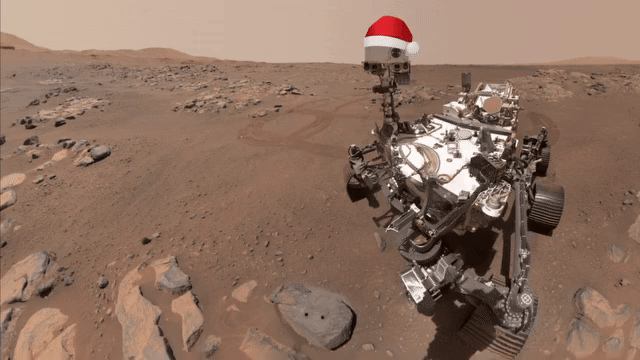The inactive aeolian megaripple, “Hazyview,” that Perseverance studied while passing through the “Honeyguide” area. NASA's Mars Perseverance rover acquired this image on Dec. 5, 2025 (Sol 1704) at the local mean solar time of 12:33:53, using its onboard Left Navigation Camera (Navcam). The camera is located high on the rover's mast and aids in driving.
NASA/JPL-Caltech
Written by Noah Martin, Ph.D. student and Candice Bedford, Research Scientist at Purdue University
While much of Perseverance’s work focuses on ancient rocks that record Mars’ long-lost rivers and lakes, megaripples offer a rare opportunity to examine processes that are still shaping the surface today. Megaripples are sand ripples up to 2 meters (about 6.5 feet) tall that are mainly built and modified by wind. However, when water in the atmosphere interacts with dust on the ripple surface, a salty, dusty crust can form. When this happens, it is much harder for the wind to move or shape the megaripple. As such, megaripples on Mars are largely considered inactive, standing as records of past wind regimes and atmospheric water interactions over time. However, some have shown signs of movement, and it is possible that periods of high wind speeds may erode or reactivate these deposits again.
Despite Mars’ thin atmosphere today (2% of the Earth’s atmospheric density), wind is one of the main drivers of change at the surface, eroding local bedrock into sand-sized grains and transporting these grains across the ripple field. As a result, megaripple studies help us understand how wind has shaped the surface in Mars’ most recent history and support planning for future human missions, as the chemistry and cohesion of Martian soils will influence everything from mobility to resource extraction.
Following the successful investigation of the dusty, inactive megaripples at “Kerrlaguna,” Perseverance recently explored a more expansive field of megaripples called “Honeyguide.” This region hosts some of the largest megaripples Perseverance has seen along its traverse so far, making it an ideal location for a comprehensive study of these features. The megaripples at “Honeyguide” rise higher, extend farther, and have sharply defined crests with more uniform orientation compared to those at “Kerrlaguna.” The consistent orientation of the megaripples at “Honeyguide” suggests that winds in this area have blown predominantly from the same direction (north-south) for a long period of time.
At “Honeyguide,” Perseverance studied the “Hazyview” megaripple, where over 50 observations were taken across the SuperCam, Mastcam-Z, MEDA, PIXL and WATSON instruments, looking for grain movement, signs of early morning frost, and changes in mineralogy from crest to trough. The investigation of the “Hazyview” bedform builds directly on the results from “Kerrlaguna” and represents the most detailed look yet at these intriguing wind-formed deposits. As Perseverance continues its journey on the crater rim, these observations will provide a valuable reference for interpreting other wind-blown features and for understanding how Mars continues to change, one grain of sand at a time.

































